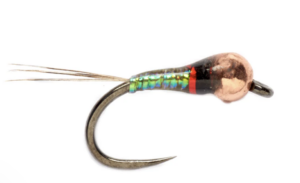Perdigon Nymph
A Perdigon fly is a type of fly-fishing nymph that’s effective for catching fish in fast-moving water:
The Spanish Nymphing Team originally developed the Perdigon fly, but the French popularized it. The name “Perdigon” is Spanish for “shot” or “pellet”.
Perdigon flies are simple, slim, and heavy, which allows them to sink quickly. They have a coated body that reduces resistance and helps them sink faster.
Perdigon flies are effective in fast-flowing rivers and streams, where trout are often looking for small flies. They can also be used in deeper, moderate currents.
Perdigon flies are versatile and durable. They often have hot colors and flash to attract attention.
Simple sleek materials, heavy bead and lead wire and oftentimes UV Resin is used to make a smooth fast sinking nymph. A hot spot is frequently used. Trout in fast water must act fast and that bit of attractive color has proven itself to be very effective. Perdigon nymph are commonly used by competitive anglers in tournaments.
Tying
Perdigon flies can be tied quickly, even when dressed up. Some recommend using a flat thread to avoid creating a round shape on the thread. A jig hook can be used to lessen snagging on the bottom or obstacles.
- Hook: 14-20 nymph or jig hook
- Tying thread: Florescent Orange or Pink
- Tail: partridge or coq de leon
- Body: varied reflective materials or quill body material

